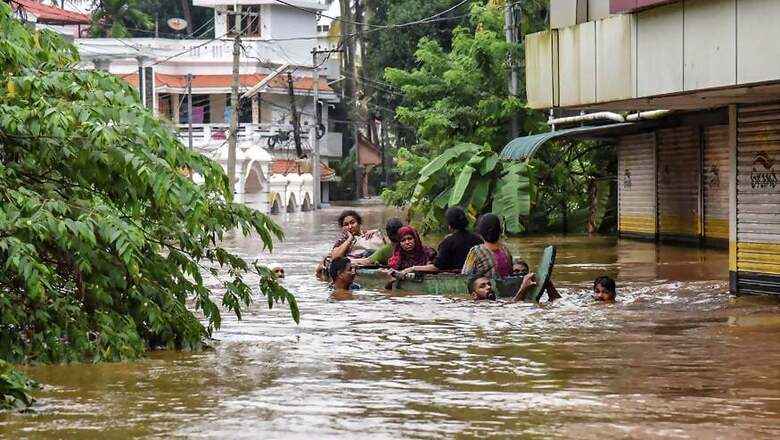
views
This story was originally published in Mongabay. It is republished here as part of News18.com’s partnership with Covering Climate Now, a global collaboration of more 250 media organisations to strengthen coverage of the climate story.
However, this consistent seasonal cycle has been disturbed in recent years, and has become a cause of great concern not only for India, but also other countries of the subcontinent, where 1.8 billion people live. The director-general of the India Meteorological Department has confirmed to Mongabay-India that the seasonal reliability of the annual monsoons has been changing. What used to be a steady combination of rains and sun is giving way to long periods of inadequate rainfall followed by intense rain; in short — drought and floods.
For instance in 2019, in the state of Kerala, at the southwestern tip of the Indian peninsula, June and July were months of inadequate rains, followed by a burst of intense storms in early August, causing floods and landslides in northern districts. The Kodagu and Chikkamaguluru districts in Karnataka state, northeast of Kerala, saw the same pattern. Avalanche, a river valley in the Nilgiris Mountains of Tamil Nadu state, to the east, received more than 900 millimeters (35 inches) of rain in just one day.
Mumbai, India’s commercial capital city, was flooded for weeks this year and saw bouts of intense rain following each other in quick succession. Eastward flowing rivers originating in the Western Ghats have seen increased flow and the western districts of Maharashtra, including Satara, Kolhapur and Sangli, have faced heavy floods and destruction. Northwards in Gujarat state, it was Vadodara and surrounding regions that endured the brunt of the deluge. To the north and northeast, there were floods in Himachal Pradesh, while parts of Uttar Pradesh and Bihar, and Assam states were also under water.
Juxtaposed to all this, the reservoirs supplying drinking water to the southern city of Chennai ran dry this summer. Chennai had devastating floods in December 2015, and since then has not received sufficient rains in subsequent monsoons.
While extreme weather is not new to the monsoon, the recurring fierce intensity of these widespread storms is novel. In recent years, extreme weather events (EWEs) have become more frequent, intense and widespread.
For example, when Kerala flooded in August 2018, the rains led to a domino effect of disastrous impacts. Kerala’s people were taken by surprise last year, since the previous such event happened in 1924, nearly a century ago. But similar intense rains fell in August 2019 – just a year later. Kerala was spared the devastation of 2018 this time only because the brutal rain did not happen all over the state, and the monsoon had been deficient before the EWE.
The Monsoons Drive the Indian Economy
The newly erratic monsoons are having a serious impact on the Indian economy, especially at this time with the nation in an all-round economic slowdown. Currently, the contribution of agriculture to India’s total GDP is only 16 percent, having been reduced over recent decades, but farming still employs nearly half of the country’s population, so a bad monsoon has a multiplier effect that cuts across all other sectors.
In fact, India’s business calendar begins with the southwest monsoon, as the festival season starts after the first harvest that these rains bring. As in ages past, if you have good, helpful rains, then a bountiful harvest is almost assured, which reflects in the joyousness of the annual festival, be it Diwali or Onam. But if there is drought or floods, then a pall is drawn over the festivities, and with it bad economic spill-over into the following months.
A good harvest drives domestic consumption, that gives buoyancy to the festivals and impetus to the economy. People buy clothes, goods, tractors, motorcycles and cars during such periods. A bad harvest dulls this impetus, oftentimes leading into a downward economic spiral.
The impact is worse when EWEs cause destruction of public and private property and assets, striking different parts of the country near-simultaneously. And of course, EWEs, bringing bad harvests, mean more human mortality and morbidity. Farmers, businesses and enterprises of all kinds find it difficult to recover after the severe economic shock brought by an EWE.
The Post Disaster Needs Assessment Report produced by the United Nations and Kerala government estimated the state’s economic loss after the August 2018 floods at rupees 310 billion (US$ 4.4 billion). This was a heavy blow for a small state with a meager tax base. Then came the floods of 2019 bringing more ruin, even before the earlier damage was repaired and people rehabilitated.
The impact of an erratic monsoon on agriculture is direct. Between 50 to 60 percent of Indian agriculture is still rainfed, without access to any form of irrigation. This makes farmers vulnerable to any change in monsoonal patterns; they rely on the rainfall’s arrival date, its even spread and consistent quantity. If it is late, seeds fail to sprout and young shoots wither; if the rains come in excess, then the plants drown. By the time the soil dries out, the rains may end, exposing the crops to end-of-season drought.
Add to this the problem of the use of hybrid seeds and improved varieties tailored to produce maximum yield for a specific rainfall pattern. When the rainfall pattern changes — as is happening more frequently now — the plants deliver inadequately.
Traumatized over multiple crop failures, farmers and farm labor migrate to other parts of the country to pick up other jobs or work as construction labor. Then, when an EWE strikes their new destination, they return home doubly-traumatized. Some farmers, who opt not to leave their farms even after repeated crop failures and debts, end their lives in frustration at their own hand.
Is India Prepared?
Importantly, India is aware of the EWE issue at the national policy level, and so is working to adapt. The national Economic Survey 2017-18 had a whole chapter dedicated to the impact of climate change on Indian agriculture. The survey is the document that the Union Government prepares and publishes a day before the Union Budget is presented in the parliament, and it summarizes the economic outlook for the present and future.
Using the India Meteorological Department data, the survey is detailed. It has noted the increases in average annual temperature between 1975 and 2015, and changes in average annual rainfall in the same period. The number of dry days (rainfall less than 1 millimeter in a day) and wet days (rainfall more than 80 millimeters in a day) has increased. The record clearly shows that over the past four decades India has become hotter, drier, and that EWEs have become more frequent.
The inclusion of climate change in the economic survey developed out of shift in political position that India made after many years of international negotiations. Starting in 1992, India’s position focused on the common but differing national responsibilities of the “equity principle,” spelled out in the provisions of climate change convention. In short, the understanding then was that climate change is a process caused by the historical and present-day greenhouse gas emissions of developed nations, and that the ability to emit carbon and grow economically is an equitable need of a developing country, such as India.
It was only in 2008 that India initiated its first significant policy initiative on climate change. That’s when the Manmohan Singh government constituted the Prime Minister’s Council on Climate Change and when the National Plan on Climate Change was unveiled.
Despite India continuing to emphasize the equity principle at the annual UN Conference of Parties (COP) at Paris in December 2015, it communicated to the world then an ambitious intended nationally determined contribution to ameliorate climate change. In Paris, India committed that, by 2030, it would reduce emissions intensity of its GDP by 33-35 percent of the 2005 value; generate 40 percent of its power needs from renewable sources; and create an additional carbon sink of 2.5 to 3 billion tons of carbon dioxide equivalent through additional reforestation and tree cover. Since the Paris COP, India has made good progress on the renewable energy front too.
However, with the monsoons becoming erratic, India will need to do more, strengthening the climate resilience of its communities — whether they be rural villages, towns or cities. The development of effective policy planning will be especially dependent on scientific models that project scenarios at higher resolutions; at the state, district and local levels. The climate change scenarios developed by the Assessment 5 Report of the UN Intergovernmental Panel on Climate Change (IPCC) only gives a South Asia-level climate change pathway, which is far too low in resolution to be useful for accurate forecasting.
State action plans on climate change (SAPCC) were supposed to represent climate change scenarios at least up to the state level. But different states have developed SAPCCs of differing quality. While Tamil Nadu has been effective in developing a state-level projection through 2100, neighboring Kerala’s analysis has been found wanting in such granular data, and its action plan is still a work in progress.
Without micro-level projections, mid- and long-term preparedness will be difficult. In recent terms, experience has shown again-and-again that preparedness plans are always seen to be lacking or insufficient when disaster strikes. Importantly, fine-tuned emergency drills will need to be developed and practiced at the local government level to protect people and property against EWEs.
If India is able to begin dealing with present-day climate variability effectively, then it will be moving in the right direction to deal with future, intensifying EWE scenarios. As of now, climate change seems to have come knocking early, and there is no way of predicting with precision what path it will take in the coming decades. Preparedness is the best way forward.

















Comments
0 comment